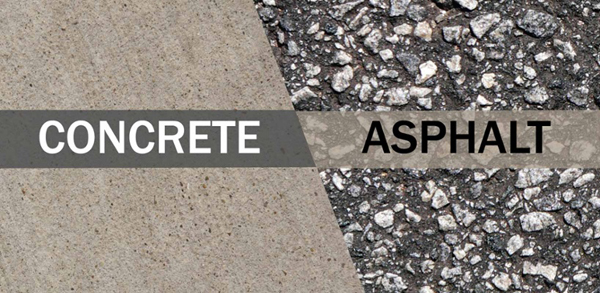What are the advantages of concrete vs. asphalt? How do the initial installation and ongoing maintenance costs differ? Is asphalt or concrete the best choice for my project? You have questions… We have answers!
First, before examining the differences, let’s look at the similarities. Concrete and asphalt both require compacted bases of gravel before they are applied. Both take time to ‘cure’ before they can be driven on but, whereas concrete can take up to 21 days to come to 95% strength, asphalt only takes a few hours.
Interestingly, although they look very different, both are made from the same general material; i.e. stone and sand. The difference in their appearance is due to the adhesive used for bonding; in asphalt it is tar and in concrete its cement. That difference is what not only gives asphalt and concrete their unique characteristics but also affects the difference in cost, durability and maintenance.
When making the decision to choose either asphalt or concrete for your project, there are a number of factors to consider:
- Aesthetics
- Concrete, allows for a variety of finishes, which can also be stained or tinted to a wide variety of colors and patterns. In addition, concrete can be stamped into different designs, etched, or engraved. Asphalt, on the other hand, due to how it is applied (i.e. rolled and compressed), has very little in the way of unique finishes. But, although black asphalt is pretty much the standard, there are tints that can be added either during mixing or to the sealant. In addition, there are also a few patterns that can be rolled to create a design in asphalt.
- Climate
- Cold, freezing winters can cause a number of issues with concrete, such as cracking and frost heaving. And the associated use of salts for ice control can damage the appearance of concrete.* At the other end of the spectrum, the tar in asphalt can become soft during hot summers, becoming tacky and possibly even deforming. Climate is a very important factor when deciding to use either asphalt or concrete and one that should be discussed with a reputable, knowledgeable contractor.
*Learn how salts used for ice control can cause significant damage to porous concrete.
- Cold, freezing winters can cause a number of issues with concrete, such as cracking and frost heaving. And the associated use of salts for ice control can damage the appearance of concrete.* At the other end of the spectrum, the tar in asphalt can become soft during hot summers, becoming tacky and possibly even deforming. Climate is a very important factor when deciding to use either asphalt or concrete and one that should be discussed with a reputable, knowledgeable contractor.
- Maintenance
- A properly installed asphalt project, depending on the sub base installation and type usage, is usually only good for 20 years or less and must be maintained over that lifespan; i.e. it must be sealed every 3-5 years.
- It is not necessary to seal concrete but doing so can preserve the look and finish, and help guard against oil-based stains.
- Cost
- Asphalt pricing is subject to variations in the price of crude oil but will generally fall into a range between $2.50 & $4.00 per square foot. By comparison, a basic concrete installation is in the range of $4 to $6 per square foot. However, concrete, with a longer life expectancy and less required maintenance, is usually the more economical choice.
The thickness of each material also impacts the price; e.g. an asphalt overlay can be as thin as 2″ or, as in the case of a truck driveway, as thick as 8″, and concrete can be as thin as 4″ or, for installations such as truck pads, as thick as 8″.
- Asphalt pricing is subject to variations in the price of crude oil but will generally fall into a range between $2.50 & $4.00 per square foot. By comparison, a basic concrete installation is in the range of $4 to $6 per square foot. However, concrete, with a longer life expectancy and less required maintenance, is usually the more economical choice.
In addition to the above, other important factors, specific to each unique project, must be considered before making an informed decision; e.g. the specific use of the surface, the condition of the subbase, area restrictions, regulations, etc. And, once the asphalt-or-concrete decision is made, there’s another round of comparative details to consider, as there are many types of asphalt mixes that are appropriate depending on the situation, and there are a variety concrete types and strengths, from a slurry mix used as a fill mix, to a high early mix that is appropriate for situations such as a highway bridge repair and can be driven on in a couple of hours.
Need more information or assistance in making the best decision? Contact us to discuss, and receive a quote on, your project.

